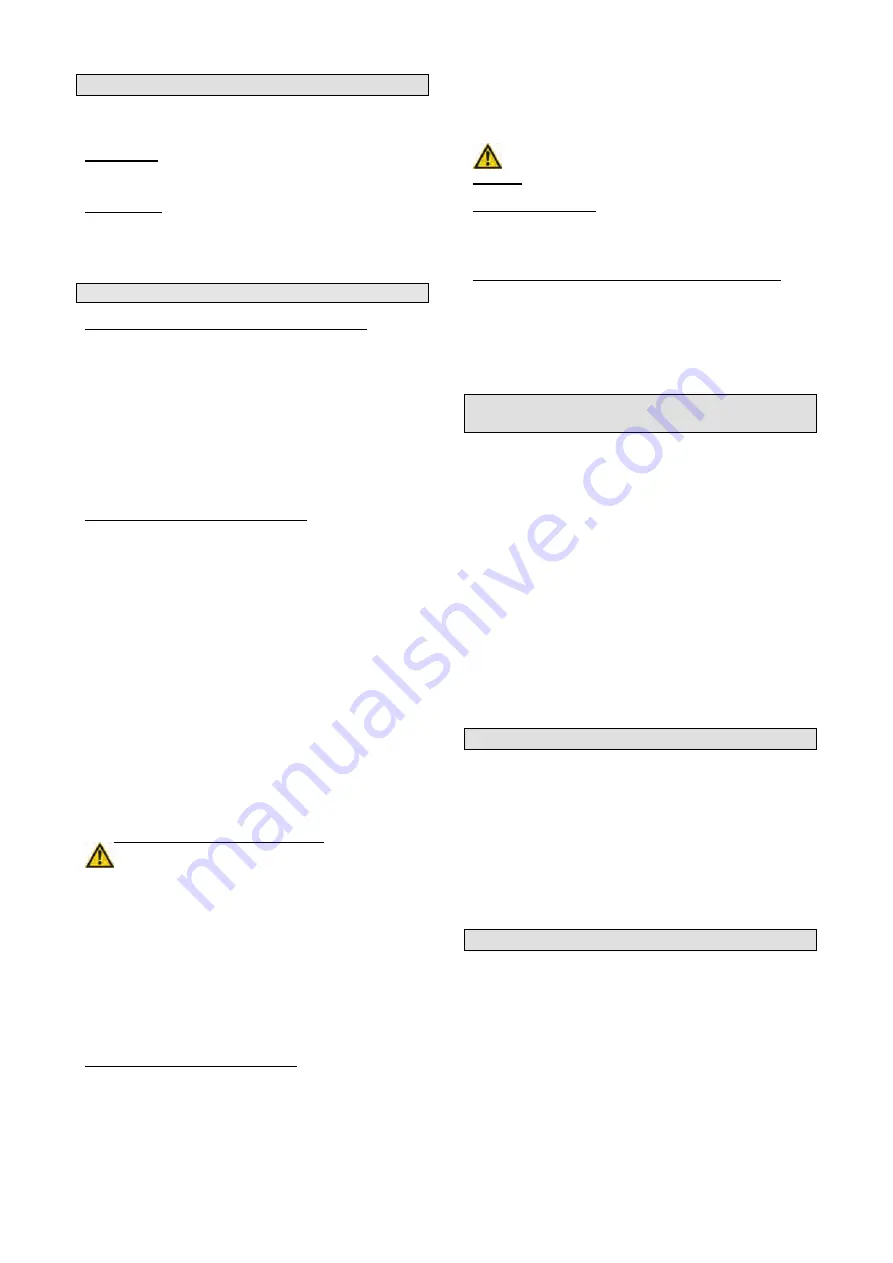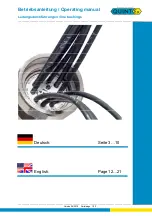
Operating staff requirements
The operating staff must carefully read the Operating
Instructions before using the appliance.
Qualification
Apart from the detailed instruction by a professional no special
qualification is necessary for using the appliance.
Minimum age
Only persons over 18 years of age can work with the
appliance. An exception includes youngsters if they work
within their professional education the purpose of which is to
obtain knowledge supervised by a trainer.
Inspections and servicing (pic. 2+7+8)
Safety instructions for inspections and servicing:
Only a regularly serviced and treated appliance may be a
satisfactory aid. Inadequate servicing and maintenance may
lead to unforeseen accidents and injuries.
•
Never use aggressive cleaning agents to clean the
appliance. That could damage or destroy the
appliance.
•
Unplug the appliance.
•
Have any repairs and servicing of the electrical
equipment provided by electricians only.
•
All protective and safety equipment must be immediately
refitted after repairs and servicing works are finished.
The following is recommended (pic. 2):
•
Splitting knife
The splitting knife is a component that is subject to quick
wear and must be ground down additionally if necessary.
That will increase the splitting output and protect the
splitter.
Tip: lubricate the splitting knife with fat!
•
Two-hand protective equipment
The combined holding and clamping equipment must run
easily. From time to time, lubricate it with a few drops of
oil.
•
Splitting post
Every time the appliance is to be used, lubricate the
splitting post with fat. That will increase the service life of
the sliding jaws (pic. A/2). Pull the splitting post out to the
full extent and equally apply multi-purpose fat to all 4
sides of the splitting post.
•
Movable parts
Keep the splitting knife guide clean (remove any dirt,
splinters, bark, etc.). Slide rails to be lubricated with fat.
•
Hydraulic equipment
Hydraulic connections screwing should be checked for
leaking and wear. Tighten the screwing if necessary.
Checking the hydraulic oil level (pic. 7+8):
Check the hydraulic oil level only when in a cold
condition, feeder cable disconnected and splitting post
pulled in.
On the oil level dipstick there are two notches – the lower (pic.
8/1) is the minimum hydraulic oil limit level in the tank and the
upper notch (pic. 8/2) is the maximum limit.
•
Unscrew the oil level dipstick (pic. 7/A) from the
opening.
•
Wipe the oil from the dipstick with a non-felt cloth.
•
Re-screw the dipstick in the opening.
•
Unscrew the filling screw with the dipstick again and
check whether the hydraulic oil upper limit is between
both notches.
Change the oil once a year (pic. 7+8):
•
Unscrew the oil drain plug (pic.7/A).
•
Catch the waste oil (every model with different amount)
•
Dispose the waste oil in an environment-friendly manner
•
Re-screw the oil drain plug.
No particles of dirt may get
in the oil tank.
•
Add the hydraulic oil up to the upper notch on the dipstick
(pic. 82)
•
Try the wood splitter with no load several times.
Recommended hydraulic oil: DIN ISO HLP 46
Güde Art. No.
42004
Viscosity: 46
Oil amount:
(see Technical specifications)
Oil to be added only when the splitting post is in the
engaged position.
Hydraulic equipment:
Hydraulic hoses and couplings must be checked after app. 4
hours of operation whether tight and must be tightened if
necessary.
Checking the appliance whether it is working properly
The hydraulic wood splitter is supplied in a ready-to-operate
state. The following functional checks need to be carried out
every time the appliance is to be used.
•
Let both switching handles go down and the splitting knife
as low as app. 5 cm above the table
•
Lower one switching handle at a time – the splitting knife
will remain in the selected position
Assembly of service arms, wheels and table
(pic. 1 and 4)
Assembly of service arms - pic. 1
Introduce control arm (Fig. 1/4) in the rocker switch (Fig. 1/14),
top with bolt, washer and split pin. Now the control arm (Fig.
1/4) by the method on the other fix. The protection system
(Fig. 1/13) Mount to both operating arms, each with two bolts
(Fig. 1/3).
TIP: Grease metal couplings (pic 1/15) with fat from above
and below before that!
Assembly of wheels – pic. 4
Mount on both sides of the impeller and secure both with a
cotter pin (A).
Table assembly - pic. 1
Depending on the split wood length, the table board can be
fixed in three heights - 570 mm, 770 mm and 1,060 mm.
Table locking levers (pic. 1/7) are fixed in every assembly
position. Insert the table board to the required holders (pic.
1/6).
Lift adjusting (pic. 5)
The working output can be increased for wood pieces smaller
than app. 50 cm and for more wood pieces by shortening the
backward movement of the splitting knife.
Proceed as follows:
Put a short piece of wood on the splitter table and move the
splitting knife as low as app. 2 cm above the wood. Switch the
splitter off (red button on the switch and disconnect the plug).
Now you can shorten the backward movement using the fixed
rod (pic. 5/B) by fixing the rod in the required height with the
adjusting screw (pic. 5/A).
Area of application
The appliance can only be used for wood processing. The split
material must have the following dimensions:
-
Minimum diameter: 125 mm
Maximum diameter: 400 mm
-
Wood splitting along fibre is only allowed.
-
Risk of getting jammed at branchy wood when splitting.
-
Jammed piece of wood is released by tipping on the
wood.
-
Cutting the split wood out prohibited!
11


























